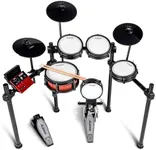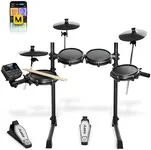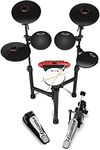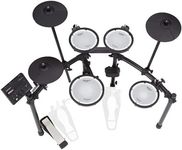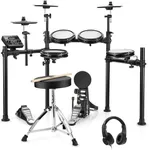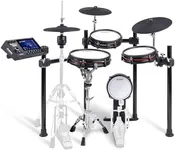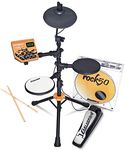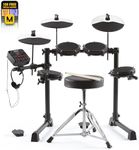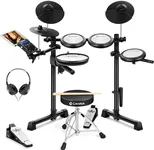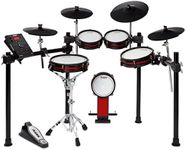Buying Guide for the Best Electronic Drum Kit
Choosing the right electronic drum kit can be a fun and rewarding experience, whether you're a beginner or a seasoned drummer. The key is to understand the various features and specifications that can impact your playing experience. By focusing on your personal needs and preferences, you can find a kit that suits your style and helps you grow as a musician.Drum PadsDrum pads are the surfaces you hit to produce sound. They can vary in size, material, and responsiveness. Larger pads can be more comfortable to play, while smaller pads might be more compact and portable. The material can affect the feel and durability; rubber pads are common and affordable, while mesh heads offer a more realistic feel similar to acoustic drums. If you're looking for a more authentic drumming experience, mesh heads might be the better choice.
Sound ModuleThe sound module is the brain of the electronic drum kit, responsible for producing the sounds you hear when you hit the pads. It contains various drum sounds, effects, and sometimes even practice tools. A module with a wide range of sounds and customization options can be great for versatile playing styles. Beginners might prefer a simpler module with fewer options to avoid feeling overwhelmed, while advanced players might look for more sophisticated features.
ConnectivityConnectivity refers to the ways you can connect your drum kit to other devices, such as computers, amplifiers, or recording equipment. Common options include MIDI, USB, and audio outputs. MIDI and USB connections are useful for recording and using software drum kits, while audio outputs are essential for live performances. Consider how you plan to use your drum kit and choose one with the appropriate connectivity options.
Built-in FeaturesBuilt-in features can include metronomes, coaching tools, and play-along tracks. These features can be incredibly helpful for practice and improving your skills. If you're a beginner, look for kits with built-in coaching tools to help you learn and stay motivated. Advanced players might appreciate play-along tracks and metronomes to refine their timing and technique.
PortabilityPortability is important if you plan to move your drum kit frequently or have limited space. Some kits are designed to be more compact and lightweight, making them easier to transport and store. If you need a kit that can be easily moved or set up in different locations, look for one that emphasizes portability without sacrificing too much on quality.
DurabilityDurability refers to how well the drum kit can withstand regular use and potential wear and tear. High-quality materials and construction can ensure your kit lasts longer and performs reliably. If you plan to use your drum kit frequently or in various settings, investing in a durable kit can save you from needing repairs or replacements down the line.
